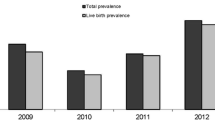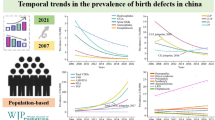Abstract
Congenital anomalies are not only one of the main killers for infants but also one of the major causes of deaths under 5. Among congenital anomalies, Down syndrome or trisomy 21 (T-21) and neural tube defects (NTDs) are considered the most common. Expectant mothers in developing countries may not have access to or may not afford the advanced prenatal screening tests. To solve this issue, this paper explores the practicality of using only the basic risk factors for developing prediction models as a tool for initial risk assessment. The prediction models are based on logistic regression. The results show that the prediction models do not have a high balanced classification rate. However, these models can still be used as an effective tool for initial risk assessment for T-21 and NTDs by eliminating at least 50% of the cases with no or low risk.

Prenatal Risk Assessment of Trisomy-21 and Neural Tube Defects




Similar content being viewed by others
Explore related subjects
Discover the latest articles, news and stories from top researchers in related subjects.References
(2016) Methods and data sources for child causes of death. World Health Organization
(2017) Maternal Screening for Foetal Abnormality, Ministry of Health, Malaysia
DNA laboratories Malaysia. http://www.dna-laboratories.com/
Sonek JD, et al. (2012) Screening at 11-13 + 6 weeks’ gestation. Ceska Gynekol 77:92–104
Khoshnood B, et al. (2000) Ethnic differences in the impact of advanced maternal age on birth prevalence of Down syndrome. Am J Public Health 90(11):1778–81
Deak KL, et al. (2008) Further evidence for a maternal genetic effect and a sex-influenced effect contributing to risk for human neural tube defects. Birth Defects Research. Part A. Clin Mol Teratol 82(10):662–9
Shin M, et al. (2009) Prevalence of Down syndrome among children and adolescents in 10 regions of the United States. Pediatrics 124(6):1565–1571
Vogenberg FR (2009) Predictive and prognostic models: implications for healthcare decision-making in a modern recession. Am Health Drug Benefits 2(6):218–22
Steyerberg E (2009) Clinical prediction model - a practical approach to development, validation and updating. Springer, New York
Hallen S, et al. (2014) Physicians’ perceptions of the value of prognostic models: the benefits and risks of prognostic confidence. Health Expect 18:6
Merkatz IR, et al. (1984) An association between low maternal serum alpha-fetoprotein and fetal chromosomal abnormalities. Am J Obstetr Gynecol 148:886–894
Wald NJ, et al. (1996) Prenatal screening for Down’s syndrome using inhibin-a as a serum marker. Prenat Diagn 53:16–23
Brizot ML, et al. (1995) Maternal serum hCG and fetal nuchal translucency thickness for the prediction of fetal trisomies in the first trimester of pregnancy. British J Obstetr Gynecol 32:102–127
Wald NJ, et al. (2003) First and second trimester antenatal screening for Down’s syndrome: the results of the serum, urine and ultrasound screening study (SURUSS). J Med Screen 10:56–66
Cicero S, et al. (2001) Absence of nasal bone in fetuses with trisomy 21 at 11-14 weeks of gestation: an observational study. Lancet 358:1665–1673
Matias A, et al. (1998) Screening for chromosomal abnormalities at 11-14 weeks: the role of ductus venosus blood flow. Ultrasound Obstetr Gynecol 2:380–384
Huggon IC, et al. (2003) Tricuspid regurgitation in the diagnosis of chromosomal anomalies in the fetus at 11-14 weeks of gestation. Heart 89:1071–1079
Uzun O, et al. (2013) Prenatal risk assessment of trisomy 21 by probabilistic classifiers. In: Signal processing and commun. applications conf. Haspolat, pp 1–4
Gersnoviez RJ (2011) Optimizing a first-trimester predictive model for trisomy 21. Proquest, Umi Dissertation Publishing
Neocleous AC, et al. (2016) First trimester noninvasive prenatal diagnosis: a computational intelligence approach. IEEE J Biomed Health Inform 20(5):1427–1438
Neocleous AC, et al. (2016) Intelligent non-invasive diagnosis of aneuploidy: raw values and highly imbalanced dataset. IEEE J Biomed Health Inform 21(5):1271–1279
(2006). Adverse pregnancy outcome reporting system public data set. Illinois Department of Public Health October
Tharwat A (2018) Classification assessment methods. Applied Computing and Informatics, 2018
Kutner MH et al (2004) Applied linear regression models, 4th edn. McGraw-Hill Irwin
Albasri A, et al. (2018) Hypertension referrals from community pharmacy to general practice: multivariate logistic regression analysis of 131 419 patients. British J General Pract 68(673):541–550
Wulsin LR, et al. (2015) Autonomic imbalance as a predictor of metabolic risks, cardiovascular disease, diabetes, and mortality. J Clin Endocrinol Metabol 100:2443–2448
Algamal ZY, et al. (2015) Regularized logistic regression with adjusted adaptive elastic net for gene selection in high dimensional cancer classification. Comput Biol Med 67:136–145
Delacour H, et al. (2005) ROC (receiver operating characteristics) curve: principles and application in biology. Ann Biol Clin (Paris) 63(2):145–54
Acknowledgements
The authors would like to acknowledge the Universiti Teknologi Malaysia (UTM) for providing the facilities and environment for completion of this work.
Author information
Authors and Affiliations
Corresponding author
Additional information
Publisher’s note
Springer Nature remains neutral with regard to jurisdictional claims in published maps and institutional affiliations.
Rights and permissions
About this article
Cite this article
Khattak, M.T., Supriyanto, E., Aman, M.N. et al. Predicting Down syndrome and neural tube defects using basic risk factors. Med Biol Eng Comput 57, 1417–1424 (2019). https://doi.org/10.1007/s11517-019-01969-0
Received:
Accepted:
Published:
Issue Date:
DOI: https://doi.org/10.1007/s11517-019-01969-0




